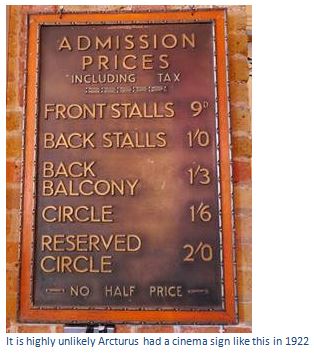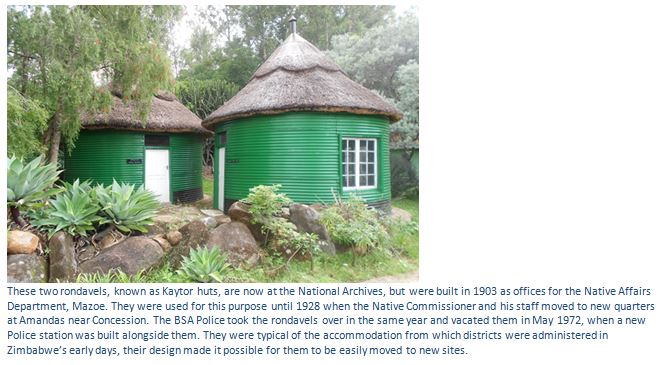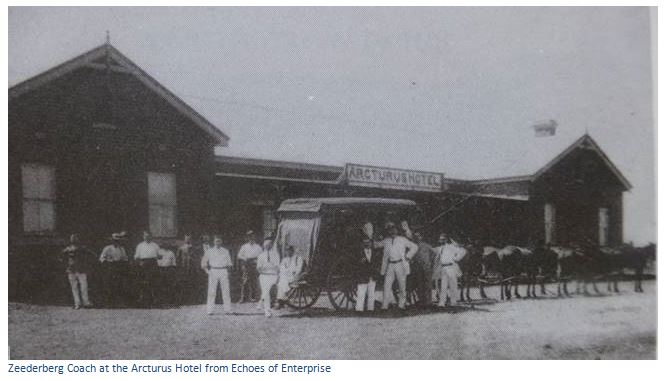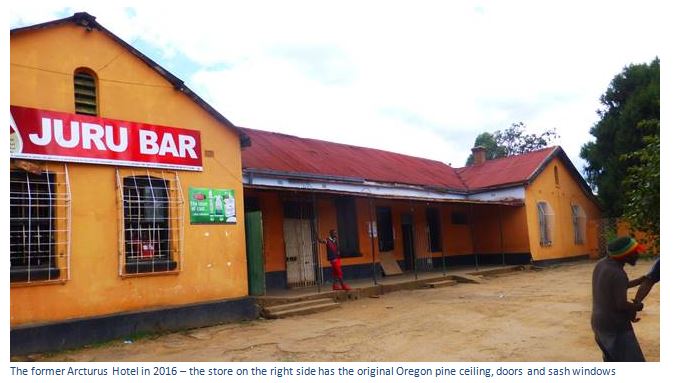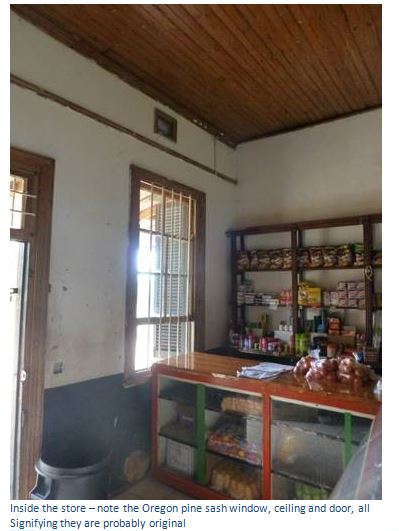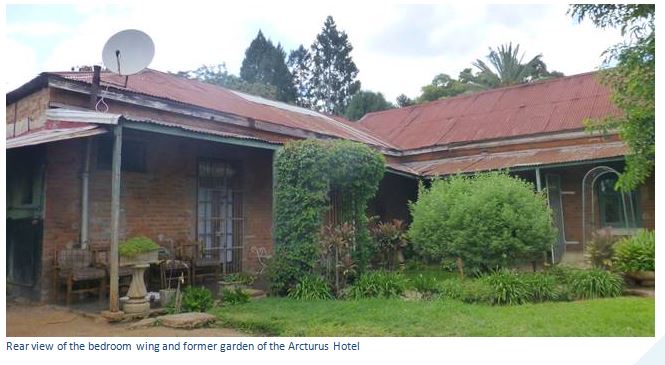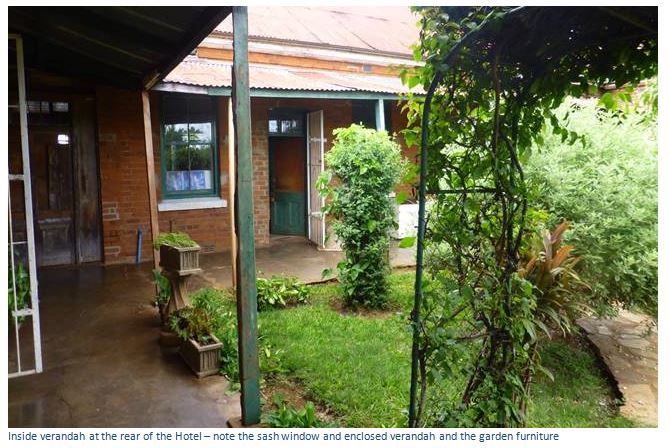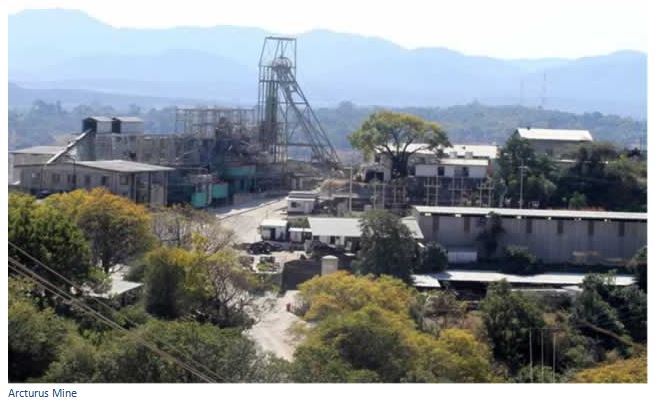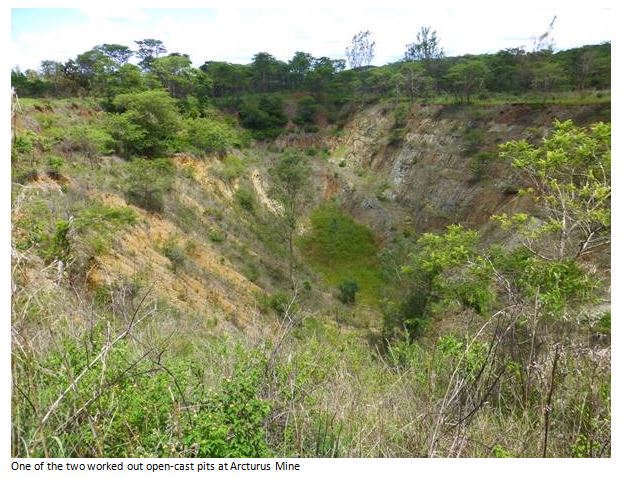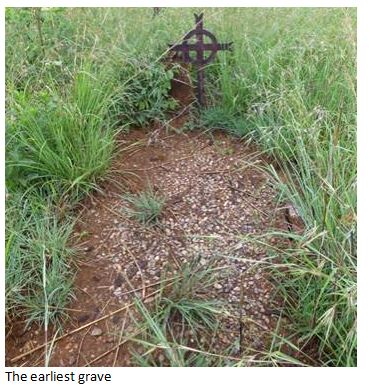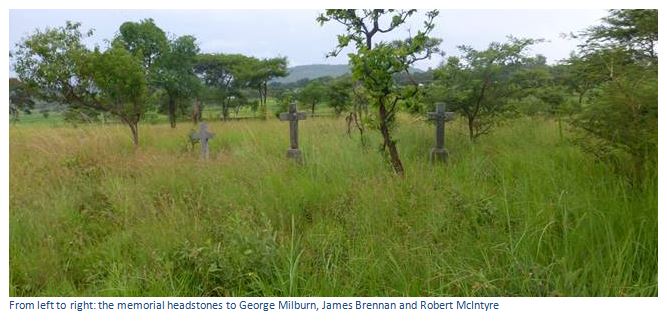Arcturus village
The village was once an overnight trek away from Harare by ox-wagon which usually went via the Arcturus road route to avoid the steep ascents of the Enterprise Road route.
The old Arcturus Hotel Store / Hotel built in 1908 by still remains architecturally recognizable with the bar section still functioning in its new guise as the Juru Bar.
The Arcturus Mine continues to operate, although on a diminished basis, and there is talk of its closing down, just as in 1924 when a closing down sale was held.
The Arcturus cemetery has early residents, as well as the graves of mine accidents.
The most notorious episode in the the villages's history was the robbery of the mine payroll and murder of the mine manager and mine secretary by the mine engineer, Berwick James, on 30th April 1978. See the article Arcturus Mine murders and payroll robbery in 1978 on the website www.zimfieldguide.com.
Route 1: Take the (A2) Enterprise Road, passing through Newlands and Chisipite and continuing on until the toll gates, keeping straight on the (A2) Mutoko / Nyamapanda Road, distances are from the toll gate. 19.1 KM turn right onto an untarred road. 20.5 KM turn right at the fork, 25.1 KM continue straight on, 29.6 KM pass the Arcturus Mine turnoff, 30.1 KM reach Arcturus Store.
Route 2: From the intersection of the Arcturus Road / Harare Drive; 2.3KM pass Chikurubi Prison, 6.1 KM pass cement factory, pass “Lion” Stevens grave on the left at entrance to Caledonia Store, this area is getting increasingly urbanised, 13.9 KM following the track of the old Planet / Arcturus railway, 21.0 KM pass track on left going to Arcturus cemetery, 21.9 KM reach old Arcturus Hotel / Store.
The turnoff for the Arcturus cemetery is 0.9 KM on the Arcturus Road towards Harare on the right, at 1.2 KM turn left, 1.5 KM reach the cemetery.
GPS reference for the Store / old Arcturus Hotel: 17⁰47′13.97″S 31⁰19′21.56″E
GPS reference for the Arcturus cemetery: 17⁰47′24.25″S 31⁰18′52.51″E
Arcturus the name
There are a number of articles on place names in Zimbabwe, but none mention the origin for the village of Arcturus which is named after the mine of the same name. The mine was probably named for the star Arcturus, in the constellation Boötes, which is the brightest star in the northern celestial hemisphere and the fourth brightest star in the night sky. The Aborigines, Arabs, Chinese, Indians and Polynesians all had local names for Arcturus.
Early days
In 1922, Arcturus was up and coming when George Milburn decided to leave Marandellas (now Marondera) The quickest way then to get to Arcturus was by mixed train from Marondera and then on the Arcturus Express, a narrow 2 foot (61cm) gauge railway which joined the mainline at Ruwa and had been built in 1920. Travel was for free, but travellers were required to sign a document which indemnified the railway from any damages to themselves, or their baggage, as there was frequent derailments on the 2 foot gauge track. George then chose the least uncomfortable looking goods truck and perched himself and his luggage on top of the tarpaulin. The journey to Arcturus was mostly downhill from Ruwa to Arcturus with the carriages rocking wildly from side to side as they went through the narrow cuttings.
In Marandellas, George had been a general clerk for Peter Wynn, a general dealer and agent who owned a store opposite the railway station. At the time Marondera comprised two European stores owned by Wynn and Bernstein, some African stores, the hotel, butchery and the railway station, but of the two places Arcturus looked the brighter star as the film shows which came up from Beira went to Arcturus before going to Salisbury (now Harare) and even the circus visited Arcturus first!
Although Salisbury by this time probably had a movie theatre consisting of a single auditorium with rows of comfortable padded seats, as well as a foyer area containing a box office for buying tickets, a counter and/or self-service facilities for buying snacks and drinks, it is most likely that in Arcturus the projector played the film onto a sheet temporarily hung up on a wall.
The Store
George Milburn started working the same day with John Grant who traded under the name of the Gold Schist (Enterprise) Trading Store. As Kathie McIntosh and Libby Norton in their book Echoes of Enterprise in the chapter on Arcturus, the store offered a wide range including: Grocers and Provision Merchants, outfitters and Drapers, Butchers and Bakers and Produce dealers: “Shipments of groceries and provisions arrive weekly. We thus guarantee the freshness of our stocks.” Her article lists the prices of many groceries including haddock, herrings, lobster, oysters, prawns and salmon, all of which were tinned, indicating local residents also enjoyed the occasional luxury.
The outfitting department in 1910 offered tweed and gabardine suits, natural wool and flannel undervests and pants and stated: “we are always well posted in the latest fashions and new stocks are constantly arriving.” The drapery section sold a wide selection of ladies goods and haberdashery promising: “anything we are unable to supply, we shall be pleased to buy ex Salisbury stocks and supply at Salisbury prices.”
The Post Office
The Arcturus Post and Telegraph Agency had opened in 1910 taking over from the Postal Agency which had operated from 1898 at Fort Enterprise. The initial Arcturus Postal Agency had operated from a pole and dhaka thatched hut in the Arcturus Mine housing area. In 1914 it was moved into a Kaytor hut near the old railway station at Arcturus Mine.
In 1915, they moved to a two roomed brick building with a corrugated iron roof next to the hotel on the main road when it became a full Post Office; Claud Milburn, George’s elder brother, was Postmaster.
In 1921, it reverted back to a Post and Telegraph Agency run by John Grant as the postal agency and re-located to his Arcturus Hotel which was known as the Goldschist Enterprise Trading Company. The billiard room was made into a store, the bar became the Post Office and both had separate entrances from the front verandah. The old Post office became a grain mill and maize storage depot.
When George Milburn arrived in 1922, he became Arcturus de facto Postmaster, a post he kept until 1947, when he handed over the Postal Agency to Stan Carey. Stan Carey wrote: “when we were transferred to Arcturus in 1947, the Public Works Department (PWD) had done up this old building, which had walls 50 cm thick, for the Postmaster’s house. We were very happy in this house except for the fishmoth which were in their hundreds, a carryover from the days when it was a maize mill and storeroom. It still is the basis of the present postmaster’s house with extra bedrooms having been added.”
The Arcturus switchboard had lines to Harare, Murewa, Mutoko, the Police and Native Commissioner at Goromonzi, and party lines for the whole Arcturus area which initially Stan operated along with the telegraph and the store counter. Despite a small population this kept him busy until later when his wife, Rene, operated the telephone exchange.
The Post Office moved to its present site, some 100 metres from the old Arcturus Hotel in 1951.
The Arcturus Hotel
This was originally built with its distinctive twin-gables and large verandah in 1908 by Mr Conway. The trading store occupied one of the large rooms entered from the verandah; the remainder of the building comprised the hotel sitting and dining rooms, and five bedrooms for overnight guests which were in the rear wings of the building.
In 1910 the hotel was bought by John Grant who added a billiards room, which became a great source of entertainment for local men. Monthly meetings were held at the hotel by The Enterprise Farmers Association which lasted all day with a break for lunch generally featuring Mrs Grant’s renowned steak and kidney pie.
Transport in the district
For many of the early years Doel Zeederberg and his three brothers were contracted to transport the mail and passengers through Mashonaland and later Matabeland. This included many routes to the smaller destinations, including Mazowe and Arcturus, as can be seen in the photo above. The coaches were pulled by a team of ten mules, which were far superior to oxen and horses, as they were unaffected by Rinderpest and East Coast Fever. Travellers from Mutoko and Murewa would spend the night at the Arcturus hotel before travelling on to Salisbury (now Harare) the next day. Because of the bad roads, swollen rivers during the rains and the heavy loads, the ten mules were changed frequently at stage posts.
On leaving Salisbury (now Harare) the first stage post was at Manresa Farm, where the cement factory is today; the next at Arcturus where a piece of land was set aside behind the hotel, and the next at Oribi Farm, before reaching Murehwa. Mrs Fletcher describes in Echoes of Enterprise (P47) how after the coach was stuck in a bog all the passengers were forced to get out whilst the coach was pulled free. She then changed her children within the coach, which was occupied by nine passengers in a space big enough for four, whilst other passengers were balanced precariously on top of the coach among the mailbags.
In 1902 Charles Duly was the proud owner of the country’s first car; a chain driven, single cylinder, six and a half horsepower French Gladiator. By 1916, there were thirty-six vehicles, and by the 1920’s motor cars were becoming increasingly popular.
In the 1920’s, after an outbreak of East Coast fever, The Road Motor Services (RMS) with an Ashcroft petrol-driven six-wheeled vehicle carrying two and a half tons took over from Zeederberg’s service running the mail three times a week from Harare to Mutoko through Murewa and would drop off the mail bags at the Mabfen River on Atlanta farm; the waiting mail runner would load them on his bicycle and cycle the fifteen kilometres to Arcturus. After a night stop in Mutoko, the RMS bus would collect the outgoing mail from the same spot and deliver it into Harare.
Arcturus Mine
The gold extracted has always supplied the main impetus behind the small centre of Arcturus and the Arcturus Mine was first registered by T.W. Fletcher on 12th September 1891, with the Slate and Planet Mines opening later. Early records are incomplete, but in 1910, a company called Gold Schist of Rhodesia Ltd amalgamated with the Rhodesian Exploration Development Company; then in 1911 the Planet-Arcturus Gold Mine Company was formed to control the original three mines.
On the 17th January 1913, a tragic dynamite accident in the Slate Mine resulted in the deaths of twenty-nine miners, including Robert McIntyre and James Brennan who are buried in the nearby Arcturus cemetery.
The three mines were all let on tribute between 1914 – 1924, and were all connected on the second and third levels, with a new shaft in 1914 which connected all three mines. Goldfields of Rhodesia Development Company had the lease from 1918 and built the Arcturus Express, the narrow gauge railway which joined the mainline at Ruwa.
However, a shortage of manpower during WWI kept back production, the ore pillars had been taken out in the Slate area and most ore in the Arcturus section down to the fifth level, so there was a closing down sale in 1924 which was well attended with > 500 people present. During the procedures “scrap iron” Cohen was testing a compressor when it blew up with an explosion that could be heard for miles around; but despite the crowds, there was only one casualty.
During the 1930’s the slimes dumps were reprocessed, no underground mining took place as a fire had burnt out the vertical shaft.
In 1940 W.S. Senior, a former Minister of Mines, purchased the mine and had it de-watered and in production again by 1945, as the Arcturus Mines Ltd, but he was killed in an air accident. The entire share capital was taken over by Coronation Syndicate Limited, who had Lonrho acting as their managers and consulting engineers. Development then took place on a large scale and in the first fifteen months >15,000 tons of ore were milled recovering >124 kilograms (4,000 oz.)
From 1946 the main shaft was deepened to 220 metres and a new reduction plant was installed. However, increased wages and difficulties treating the ore because of copper content, caused economic difficulties, but a subsidy from the Royalty Review Commission did help. The introduction of tungsten carbide tipped jack hammers in 1951 increased development footage by 100% and electric-battery underground tram cars resulted in a considerable increase in ore milled to 53,000 tons in 1956.
The old slate mine reef which had been lost through faulting was re-discovered in 1952 giving rich gold reef values; the mine had been given a new lease of life and the vertical shaft was deepened to 534 metres.
By the 1960’s there were signs the ore body was running out and the mine was sold to Mazoe Consolidated Mines limited in 1965. The situation was looking bad by 1967 again, until a diamond drill-hole in the footwall of the drive discovered the “Venus Reef.”
The Arcturus Mine had a new lease of life and continued producing despite flooding affecting production, lower ore grades and declining gold prices. Mining was switched from underground to open cast and the mine had an output of about 30 kilogrammes per month in 2013 under its new owners, Metallon Gold Zimbabwe. Management have said, despite continuing operating losses, they were trying to keep operations going and hoped they would not have to shut down Arcturus Mine.
The Arcturus Cemetery
The earliest grave on the eastern side of the cemetery has a pioneer iron cross, but is unnamed and we will probably never know who is buried here.
The Dominion Newspaper published in New Zealand on 22nd January 1913 reported the deaths in a dynamite explosion of two white and twenty-seven African miners in the Slate Mine, Arcturus. Robert McIntyre and James Brennan were both killed on the 17th January 1913 and are buried next in the cemetery.
George Milburn was the Arcturus postmaster from 1922 to 1947 and quoted in the article above. His memorial states he was born at Ovingham in the Tyne valley of south Northumberland, England on 13th April 1900 and died at Arcturus on 26th February 1980.
Stanley Richard George Carey, who succeeded George Milburn as Arcturus postmaster in 1947 was born on the 4th April 1917 and died on the 7th February 1993.
Finally, the joint grave of Pauline James (22nd November 1904 – 22nd July 1980) and Lawrence James (12th February 1906 – 19th July 1980) Are they the parents of Berwick James, the Arcturus Mine engineer convicted of murdering the Arcturus Mine manager and mine secretary on 30th April 1978?
Acknowledgements
K. McIntosh and L. Norton. Echoes of Enterprise. Enterprise Farmers Association.

